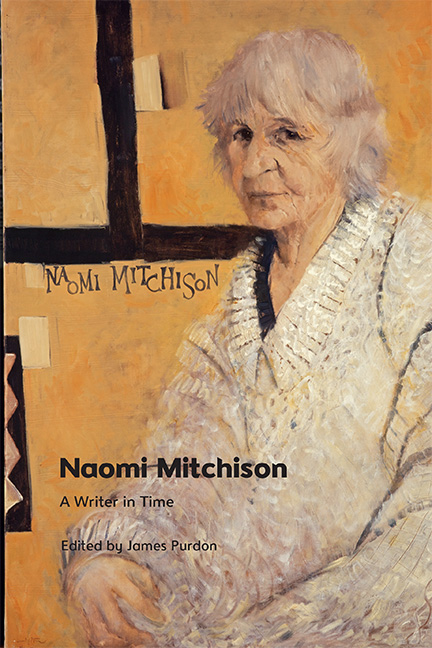Book contents
- Frontmatter
- Contents
- Acknowledgements
- Notes on Contributors
- Introduction
- 1 Naomi Mitchison’s Interwar Short Stories
- 2 ‘She had her hand on the plow’: Shame, Uncertainty and Transformation in The Corn King and the Spring Queen
- 3 Varieties of Sexual Experience: Naomi Mitchison, Mysticism and Gerald Heard
- 4 Scientific Temporalities in We Have Been Warned and ‘Beyond This Limit’
- 5 Send in the Clones? Naomi Mitchison and the Politics of Reproduction and Motherhood
- 6 From Argyll with Love: Naomi Mitchison and the Soviet Union
- 7 Fire or Blood? Aestheticising Resistance in Naomi Mitchison’s The Blood of the Martyrs
- 8 ‘The summoning urgent thing’: The Bull Calves and the Drive to Experiment at Mid-Century
- 9 Mitchison, Decolonisation and African Modernity
- Naomi Mitchison’s ‘Europe’
- Europe
- Bibliography
- Index
5 - Send in the Clones? Naomi Mitchison and the Politics of Reproduction and Motherhood
Published online by Cambridge University Press: 18 November 2023
- Frontmatter
- Contents
- Acknowledgements
- Notes on Contributors
- Introduction
- 1 Naomi Mitchison’s Interwar Short Stories
- 2 ‘She had her hand on the plow’: Shame, Uncertainty and Transformation in The Corn King and the Spring Queen
- 3 Varieties of Sexual Experience: Naomi Mitchison, Mysticism and Gerald Heard
- 4 Scientific Temporalities in We Have Been Warned and ‘Beyond This Limit’
- 5 Send in the Clones? Naomi Mitchison and the Politics of Reproduction and Motherhood
- 6 From Argyll with Love: Naomi Mitchison and the Soviet Union
- 7 Fire or Blood? Aestheticising Resistance in Naomi Mitchison’s The Blood of the Martyrs
- 8 ‘The summoning urgent thing’: The Bull Calves and the Drive to Experiment at Mid-Century
- 9 Mitchison, Decolonisation and African Modernity
- Naomi Mitchison’s ‘Europe’
- Europe
- Bibliography
- Index
Summary
Themes around reproduction manifested early in Naomi Mitchison’s life, even though she was brought up in the sheltered fashion appropriate to upper-middle-class Edwardian girlhood. As far as specific sexual knowledge in adolescence went she could only evoke ‘a real memory blank, a depth of embarrassment, into the bottom of which my fishing memory cannot reach’. But health problems (perhaps) had led to her sharing her mother’s bedroom from the age of ten, ‘fairly certain that my presence was to ensure that my father should not be allowed in’, either to avoid family increase – though her mother spoke vaguely of ‘Malthusian capsules’ to Naomi in the prelude to her marriage, indicating some knowledge of contraception – or from distaste for marital sex.
Her mother, an adherent of Edwardian feminist social purity eugenics, instructed Naomi that if anyone proposed marriage, to ‘ask whether he had ever had anything to do with another woman’. This was both an ideological commitment to attacking the sexual double standard, which saw sexual licence as permissible to men but to be condemned utterly in respectable women; and practical concern about the possibility of contracting venereal disease from men who engaged in sex outside marriage. Mitchison’s autobiographical comments upon the prioritisation of conventional social expectations – ‘the standards and fine distinctions’ around class and gendered behaviour supposed to be known ‘in some subconscious way’ – suggest that her mother did not take her feminist eugenics any further. More radical agendas of the period advanced by the New Woman novelists and polemical writers such as Frances Swiney put the case that, freed from economic and social constraints, women might choose mates with an eye to their potential for fatherhood. Shortly before Naomi’s marriage to Dick Mitchison, her mother tried to convey the facts of life: ‘I thought because I had kept guinea-pigs for many years and understood Mendelian genetics as far as it had then gone, that I already knew everything.’ In fact, their first couple of years of marriage were very unsatisfactory until, as for so many of her generation, illumination came from Marie Stopes’s pioneering marriage manual, Married Love, in 1918.
- Type
- Chapter
- Information
- Naomi MitchisonA Writer in Time, pp. 73 - 88Publisher: Edinburgh University PressPrint publication year: 2023

